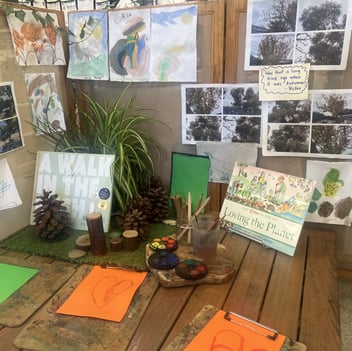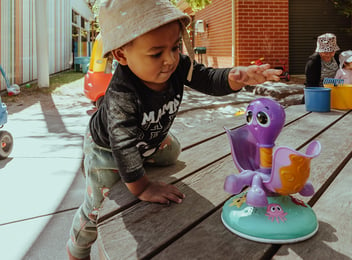High above the streets of the CBD, our educators went on a journey across Indigenous Cosmologies and transformative practice. We may have been on the 8th floor, but surrounded with garlands of local gum leaves, our brilliant speakers anchored the concepts firmly on the ground and gave us practical ways to privilege them into practice. The learning was extraordinary, and we’re excited to share some highlights from the day.
‘Becoming with Place’ and Anti-Bias were central, and Bec, Andrew, Lucas and Louise related how these ideas have transformed their everyday work in ECE and Support Services. Kate Smith, ECMS Marketing and Communications lead, described our common goal that by the end of the year, every child in our services will know where they are on Country. Kate’s moving words set the scene for our main speaker Dr Red Ruby Scarlet who inspired us to “think about the Signs, Signals and Symbols, and ask questions that keep us in a curious space.” This also speaks to the new EYLF which asks us to think about children and us as educators, as creative, curious and confident.
Clouds was Dr Red’s first touchpoint, and Playdough the vehicle to launch us from Gadigal land and beyond. Asking questions formed the first part of the session and Red described how they give educators the ability to pause, and children to ask questions in return. This, she said “is where the magic happens” with children leading conversations and deeply understanding Country.
Two Many Cheeky Dogs by Johanna Bell and illustrated by Warumungu (Tennant Creek) artist Dion Beasley formed the basis of Dr Red’s next piece about what underpins Indigenous Cosmologies. She shared wonderful images showing how children used the story to pull out sound and images, reflecting the intentionality of educators and the beautiful learning privileged across the work.
The third part of Dr Red’s session examined how babies and infants are innately deeply connected to Country because of their topographic perspective of the world. On their backs and stomachs, they view things from below and above and Indigenous Cosmologies are reflected in their childhood wonder.
Dr Red finished her session by asking educators to “dive into” a series of questions around ‘becoming with place’. After a special surprise performance (keep an eye out, we’ll be sharing this soon!) she left us with new ideas and knowledge that when we privilege Indigenous Cosmologies, we can showcase what it looks like in every aspect of our work. Children are naturally curious learners who delight in discovery and when we intentionally create a safe and creative place for learning, it invites us all of us into deeper ways of knowing, being and doing.
Read On

Wellbeing and environmental study with Deakin University
ECMS has partnered with Deakin University to undertake a study into how young children’s...
Becoming with place at Bulldogs
At ECMS our place-based approach is a core tenet of our Pedagogical Framework, inviting children to...
